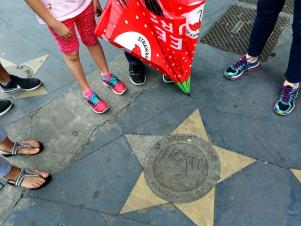 © David Silverman/Getty Images A group of tourists on a walking tour in Argentina. David Silverman/Getty Images
© David Silverman/Getty Images A group of tourists on a walking tour in Argentina. David Silverman/Getty Images
- Modern shoes are designed with features that make walking and running more comfortable and energetically efficient.
- One of those features is a toe spring — the front of the shoe — that curves upward, putting our feet in a perpetually flexed position.
- But according to a new study, toe springs may weaken our foot muscles over time, which could contribute to injuries like plantar fasciitis.
- Visit Business Insider’s homepage for more stories.
Look down at the shoes on your feet or the pairs in your closet — it’s likely their front tips curve upward. This is known as the toe spring.
“We’ve all been wearing shoes with these toe springs, and have had no idea why they’re there, the only thing we know is they seem to make walking more comfortable,” Nicholas Holowka, an anthropologist at the University of Buffalo, told Business Insider.
But according to Holowka, the comfort and efficiency this shoe design offers may do our feet a disservice in the long run. He helped publish a recent study that shows how toe springs may contribute to the weakening of foot muscles over time, consequently making us more susceptible to injuries like plantar fasciitis.
“They’re reducing the amount of work we need to do with our foot muscles, just a little bit every step,” he said.
The study offers the latest data point in an ongoing debate about whether minimalist shoes are better for our feet than supportive modern shoes.
Less effort needed to walk, but weaker foot muscles
Each step we take can be broken down into distinct parts: First, our heel strikes the ground, then our whole foot makes contact. As we move toward the next step, we shift our weight forward to our toes, then push off the ground with them.
That push, sometimes called a toe-off, requires the tiny muscles at the metatarsophalangeal joints — where the balls of our feet meet the base of our toes — to keep our foot rigid. These joints allow the transfer of energy from the foot to the ground and back.
A toe spring reduces the work these muscles must do to ensure an adequate toe-off, Holowka and his co-authors found.
They came to that conclusion after observing 13 people walk on a treadmill in various types of footwear. The participants walked barefoot, as well as in four different types of sandals with increasingly pronounced toe springs. The researchers, meanwhile, used an infrared camera system and special plates built into the treadmill to measure how much power the walkers put into each step and how much force went into the ground during their toe-offs.
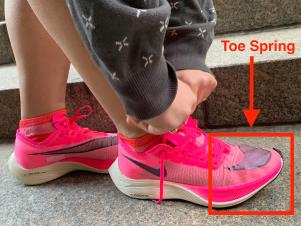 © Provided by Business Insider The upward curve at the front of modern-day sneakers is called the toe spring. Aylin Woodward/Business Insider
© Provided by Business Insider The upward curve at the front of modern-day sneakers is called the toe spring. Aylin Woodward/Business Insider
The results showed that the more a sandal curved the volunteers’ toes upward, the less power their feet needed to generate to push off the ground. Wearing a shoe with a toe spring, in other words, meant their muscles were doing less work.
“Add that up over the thousands of steps the average person takes in a day, over years,” Holowka said, and it means shoes with toe springs lead one’s muscles do a lot less work in the long-run.
“Less work means the muscles will not be as well conditioned, meaning that they may not be able to protect other soft tissues in the foot like the plantar fascia from trauma, leading to conditions like plantar fasciitis,” he added.
Weaker foot muscles could mean a higher risk of injury
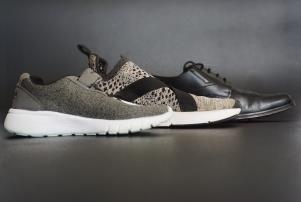 © Freddy Sichting Modern shoes like these have an upward curve at the front known as the toe spring. Freddy Sichting
© Freddy Sichting Modern shoes like these have an upward curve at the front known as the toe spring. Freddy Sichting
About 2 million Americans get treated for plantar fasciitis every year — a condition characterized by painful inflammation in the plantar fascia tissue on the bottoms our our feet. This injury, which can be common among runners, comes with a stabbing pain in the heels and arches. It’s difficult to repair.
Holowka and his colleagues suspect that toe springs may be contributing to the prevalence of this injury.
“What happens is that people are relying on their plantar fascia to do what muscles normally do,” Daniel Lieberman, a co-author of the study, said in a press release. “When you get weak muscles and the plantar fascia has to do more work, it’s not really evolved for that, and so it gets inflamed.”
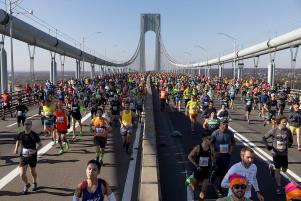 © Associated Press Runners compete in the 2019 New York City Marathon, November 11, 2019. Associated Press
© Associated Press Runners compete in the 2019 New York City Marathon, November 11, 2019. Associated Press
In addition to plantar-fascia stress, Lieberman and Holowka also found in a previous study that long-term use of modern footwear often leads to a collapsed arch.
But this doesn’t mean we should suddenly start running barefoot
Prior research has also found that people who wear minimal footwear — shoes that help approximate barefoot running and have little cushioning, arch support, or toe springs — have larger foot muscles and stiffer arches than those who wear traditional modern shoes.
“Walking and running in minimal shoes with less supportive features over a while, about six to 12 weeks, can strengthen the intrinsic foot muscles,” Freddy Sichting, the lead author of the recent study, told Business Insider.
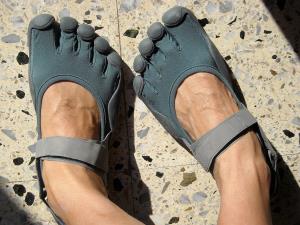 © Wikimedia Commons A pair of Vibram Five Finger minimalist shoes. Wikimedia Commons
© Wikimedia Commons A pair of Vibram Five Finger minimalist shoes. Wikimedia Commons
But that doesn’t mean we should chuck all our old shoes in the bin.
“It can take a long time to build up those muscles, and if you try to do it all at once, you could hurt yourself,” Holowka said.
Indeed, barefoot runners tend to report more calf and achilles tendon injuries.
“Most feet are likely not used to doing all the work without the support of modern shoes,” Sichting said, adding, “I would recommend a slow transition to minimal footwear to avoid overuse injuries.”
Shoes with arch support and cushioning became popular in the 1970s, which in evolutionary terms, of course, is very recent.
“If we start to wear shoes with all sorts of features to control and limit our natural foot motion, as we’ve been doing for decades now, it might mean that we’re not using our feet in the way they evolved to function,” Holowka said, adding, “this is a classic example of an evolutionary mismatch, in which our body finds itself in a novel environment — our shoes — that it has not evolved to cope with.”
Read the original article on Business Insider
Video: How Exercise Can Boost Your Immune System (Shape)




















